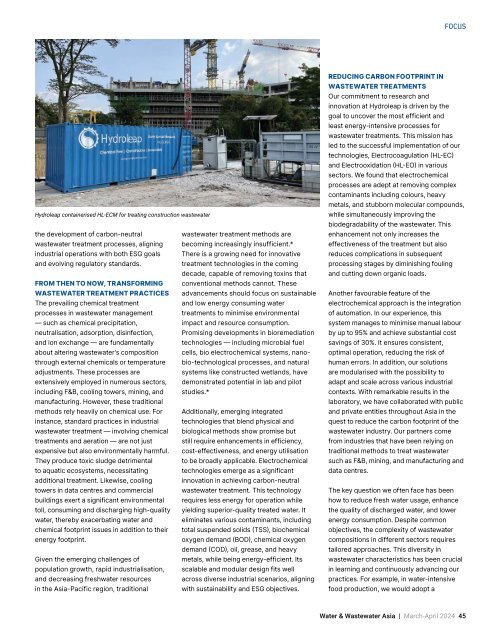Water & Wastewater Asia March/April 2024
Water & Wastewater Asia is an expert source of industry information, cementing its position as an indispensable tool for trade professionals in the water and wastewater industry. As the most reliable publication in the region, industry experts turn this premium journal for credible journalism and exclusive insight provided by fellow industry professionals. Water & Wastewater Asia incorporates the official newsletter of the Singapore Water Association (SWA).
Water & Wastewater Asia is an expert source of industry information, cementing its position as an indispensable tool for trade professionals in the water and wastewater industry. As the most reliable publication in the region, industry experts turn this premium journal for credible journalism and exclusive insight provided by fellow industry professionals. Water & Wastewater Asia incorporates the official newsletter of the Singapore Water Association (SWA).
Create successful ePaper yourself
Turn your PDF publications into a flip-book with our unique Google optimized e-Paper software.
FOCUS<br />
Hydroleap containerised HL-ECM for treating construction wastewater<br />
the development of carbon-neutral<br />
wastewater treatment methods are<br />
wastewater treatment processes, aligning becoming increasingly insufficient.*<br />
industrial operations with both ESG goals There is a growing need for innovative<br />
and evolving regulatory standards.<br />
treatment technologies in the coming<br />
decade, capable of removing toxins that<br />
FROM THEN TO NOW, TRANSFORMING conventional methods cannot. These<br />
WASTEWATER TREATMENT PRACTICES advancements should focus on sustainable<br />
The prevailing chemical treatment<br />
and low energy consuming water<br />
processes in wastewater management treatments to minimise environmental<br />
— such as chemical precipitation,<br />
impact and resource consumption.<br />
neutralisation, adsorption, disinfection, Promising developments in bioremediation<br />
and ion exchange — are fundamentally technologies — including microbial fuel<br />
about altering wastewater’s composition cells, bio electrochemical systems, nanobio-technological<br />
processes, and natural<br />
through external chemicals or temperature<br />
adjustments. These processes are<br />
systems like constructed wetlands, have<br />
extensively employed in numerous sectors, demonstrated potential in lab and pilot<br />
including F&B, cooling towers, mining, and studies.*<br />
manufacturing. However, these traditional<br />
methods rely heavily on chemical use. For Additionally, emerging integrated<br />
instance, standard practices in industrial technologies that blend physical and<br />
wastewater treatment — involving chemical biological methods show promise but<br />
treatments and aeration — are not just still require enhancements in efficiency,<br />
expensive but also environmentally harmful. cost-effectiveness, and energy utilisation<br />
They produce toxic sludge detrimental to be broadly applicable. Electrochemical<br />
to aquatic ecosystems, necessitating<br />
technologies emerge as a significant<br />
additional treatment. Likewise, cooling innovation in achieving carbon-neutral<br />
towers in data centres and commercial wastewater treatment. This technology<br />
buildings exert a significant environmental requires less energy for operation while<br />
toll, consuming and discharging high-quality yielding superior-quality treated water. It<br />
water, thereby exacerbating water and eliminates various contaminants, including<br />
chemical footprint issues in addition to their total suspended solids (TSS), biochemical<br />
energy footprint.<br />
oxygen demand (BOD), chemical oxygen<br />
demand (COD), oil, grease, and heavy<br />
Given the emerging challenges of<br />
metals, while being energy-efficient. Its<br />
population growth, rapid industrialisation, scalable and modular design fits well<br />
and decreasing freshwater resources across diverse industrial scenarios, aligning<br />
in the <strong>Asia</strong>-Pacific region, traditional<br />
with sustainability and ESG objectives.<br />
REDUCING CARBON FOOTPRINT IN<br />
WASTEWATER TREATMENTS<br />
Our commitment to research and<br />
innovation at Hydroleap is driven by the<br />
goal to uncover the most efficient and<br />
least energy-intensive processes for<br />
wastewater treatments. This mission has<br />
led to the successful implementation of our<br />
technologies, Electrocoagulation (HL-EC)<br />
and Electrooxidation (HL-EO) in various<br />
sectors. We found that electrochemical<br />
processes are adept at removing complex<br />
contaminants including colours, heavy<br />
metals, and stubborn molecular compounds,<br />
while simultaneously improving the<br />
biodegradability of the wastewater. This<br />
enhancement not only increases the<br />
effectiveness of the treatment but also<br />
reduces complications in subsequent<br />
processing stages by diminishing fouling<br />
and cutting down organic loads.<br />
Another favourable feature of the<br />
electrochemical approach is the integration<br />
of automation. In our experience, this<br />
system manages to minimise manual labour<br />
by up to 95% and achieve substantial cost<br />
savings of 30%. It ensures consistent,<br />
optimal operation, reducing the risk of<br />
human errors. In addition, our solutions<br />
are modularised with the possibility to<br />
adapt and scale across various industrial<br />
contexts. With remarkable results in the<br />
laboratory, we have collaborated with public<br />
and private entities throughout <strong>Asia</strong> in the<br />
quest to reduce the carbon footprint of the<br />
wastewater industry. Our partners come<br />
from industries that have been relying on<br />
traditional methods to treat wastewater<br />
such as F&B, mining, and manufacturing and<br />
data centres.<br />
The key question we often face has been<br />
how to reduce fresh water usage, enhance<br />
the quality of discharged water, and lower<br />
energy consumption. Despite common<br />
objectives, the complexity of wastewater<br />
compositions in different sectors requires<br />
tailored approaches. This diversity in<br />
wastewater characteristics has been crucial<br />
in learning and continuously advancing our<br />
practices. For example, in water-intensive<br />
food production, we would adopt a<br />
<strong>Water</strong> & <strong>Wastewater</strong> <strong>Asia</strong> | <strong>March</strong>-<strong>April</strong> <strong>2024</strong> 45

















